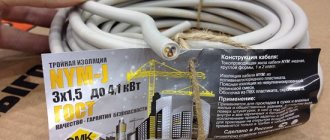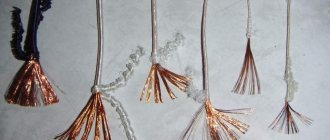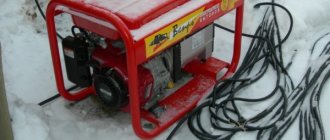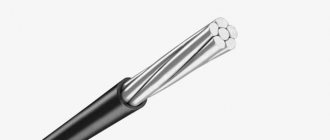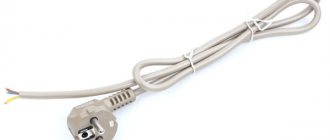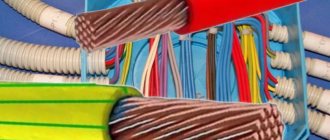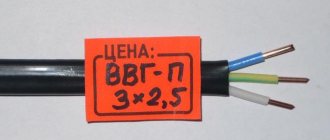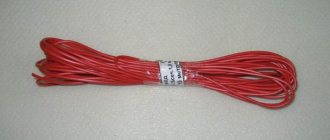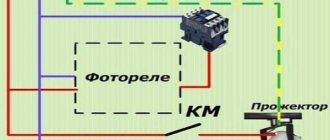To perform serial installation work, the ability of the conductor to withstand high current loads without damage is useful. Multi-core design implies integrity with a small bending radius. Reliable insulation extends service life and ensures safety during operation. PV 3 1x6 wire has the listed advantages. Its use allows you to economically and quickly create high-quality power supply lines.
Typical wire pv 3 6
Design features and marking explanation
PV3 wires of various sections
The PV-3 wire is a one-piece structure made of stranded copper core and insulation made of polyvinyl chloride. At the same time, GOST allows a single-wire design, but it is not found in stores due to several disadvantages, including low flexibility and increased fragility.
Marking:
- P - wire;
- B - PVC insulation;
- 3 - flexibility class of copper wire core.
Insulation can be either single-color or two-color. A common type of mixed color is yellow-green. This is how wires intended for organizing grounding loops are marked. Thanks to the multi-wire structure of the core, the product has high conductivity.
Specifications
Explanation of the name of the PV3 wire
The yellow-green wire PV-3 1x6 has sufficient endurance to be used in extreme conditions. Its insulation can withstand temperatures from -60 to +70 degrees Celsius. It is immune to the effects of steam or condensation.
The polyvinyl chloride from which the insulation is made is not susceptible to mold. It does not burn, but melts, which makes it possible to avoid a fire if the permissible load is exceeded and the core overheats. The advantages of insulation are strength, wear resistance and unattractiveness to rodents. The standard service life is 15 years, after which the properties of the wire may change for the worse, and it must be replaced.
With a core cross section of 6 sq. mm. PV-3 can withstand a current of up to 46 A if laid separately, and up to 35 A if four conductors go side by side. The weight of one meter of such wire with a cross-section of 6 mm2 is 0.07 kg.
The core is made only of copper. According to GOST, the use of bimetallic cores is unacceptable.
Technical characteristics of wire PVZ 1Х6
Wire PV-1
Taking into account the total assessment of insulating and conductive parameters, the operation of products in this category is permitted in a wide temperature range (from -50°C to +65°C). Even at high levels of relative humidity (up to 98%), reliable performance of basic functions is ensured. To clarify the compliance of climatic conditions, it is recommended to study the standards of the second category of the GOST 15150-69 standard.
For correct installation, the temperature should be maintained at least -15°C. This will prevent damage to the protective shell made of polymer material. If necessary, the work area is heated using specialized equipment.
If the specified conditions are met, you can create routes with a bend radius of 24 mm. To control this parameter, lengthen the wire by mechanical load by 50%. A high-quality shell retains its integrity after such extreme deformation.
Small bend radius ensures line integrity when using harness connections
The insulation is not damaged if the temperature of the conductor increases to +70°C when passing a strong current. Short-term exceeding of the nominal value up to +150°C is permissible. Electrical insulation remains functional when immersed in water for 5 minutes. with simultaneous connection to a 2.5 kV power source. These abilities are tested through standard laboratory testing procedures for finished products.
Main technical characteristics of serial wire PV 3 1x6 (different values are given according to official data from manufacturing plants):
- permissible bending radius – 23.5-24 mm (at least 5 outer diameters);
- thickness of the insulating layer – 1-1.1 mm;
- outer diameter – 4.7-4.8 mm;
- weight of 1 km of wire – 68-71 kg;
- electrical resistance of the control section of 1 km at a temperature during testing of +20°C – no more than 3.05-3.1 Ohm;
- insulation resistance – 1 MOhm;
- current – 65-67A;
- voltage (AC/DC) – 750/1,000 V;
- frequency – up to 400 Hz;
- wire length when winding on standard drums (reel type/m) – 8/900; 8b/1 950; 12/ 6 100;
- design life – 15-25 years.
For your information. In the retail network you can purchase a cable of any length with a minimum standard pitch of one meter for a commercial batch.
The affordable cost of 1x6 pvz is partly determined by its simple design. The conductor is made of several copper wires. When creating these products, GOST 22483-77 standards are used, which ensures the unchanged parameters of each product batch. In particular, annealing is used to improve flexibility. Tinning is used to simplify installation operations.
Flexibility classes (examples of cable products)
The PV 3 wire is made of no less than 7 cores. This limitation corresponds to the third category of flexibility according to current standards. Manufacturers have the right to improve this parameter.
It is not difficult to identify the purpose of individual lines during installation and repair work. Wire pv 3 1x6 yellow-green is used to connect equipment to the grounding bus. Other standard color designation methods are used in a similar way:
- blue – zero;
- white, red and others are phases.
For your information. When placing large orders, specialized enterprises can create color markings taking into account the special requirements of the customer.
The only protective shell is made of polyvinyl chloride with additives that prevent combustion. PV 3 6 wire does not belong to the special category of “non-flammable” cables. However, in case of accidents, sparks falling on the surface will not be able to provoke the formation of a flame. Of course, the melted sections of the lines will have to be replaced.
There are no additional shells in the design. The absence of a screen, for example, implies poor immunity to electromagnetic interference. This feature should be taken into account when choosing cable products. Experienced specialists advise carefully studying the features of future operation, and not just the current (voltage) modes and connected loads.
Other pros and cons are noted in the following summary list:
- The universal level of flexibility (class 3) does not limit the scope of application. Products in this category are used in everyday life and to solve industrial problems.
- An additional advantage is good load parameters in terms of permissible currents.
- You can quickly find a lost wire in a complex circuit using clearly visible color markings.
- Affordable cost will help minimize costs when working with large projects.
The insulation performs its functions flawlessly in normal operation. It is better to choose a different cable if there are increased requirements for the following items:
- noise immunity;
- resistance to open flame (smoke generation);
- protection from direct sunlight and other natural influences.
Instead of changing the type of cable, you can use a corrugated tube, specialized prefabricated channels or grooves in the walls. Particular care is taken when laying the route in wooden houses and when passing through flammable structures. In such situations, a metal pipe is used to provide reliable additional protection.
If the electrical cabinet will be used in conditions of high humidity, ensure high-quality sealing of the door and entrances with special sealing elements. Compliance with the rules discussed and taking into account technical parameters will ensure long-term operation of the wire without damage. At the same time, the legal requirements of electrical and fire safety standards will be met.
Application area
The wire can be used when installing apartment electrical wiring.
PV-3 can be used in organizing household and industrial electrical networks. Its versatility and unpretentiousness make it possible to use it when installing apartment electrical wiring, factory communications, for connecting electrical equipment in the garage, etc. Resistance to steam, moisture and condensation makes it possible to use this wire in baths, saunas and other rooms with high temperature and humidity.
Double insulation involves the use of PV3 1x25 wire when laying networks with voltages up to 1000 V only indoors. It is not capable of receiving heat from the copper core, so the likelihood of it melting during overload tends to zero. Its disadvantage is the lack of resistance to direct sunlight, so installation outdoors is prohibited.
Separately, it is worth noting the possibility of using wires during the assembly of electrical cabinets. Its flexibility and temperature resistance are ideal for creating short jumpers between power blocks. In this case, the ends must be crimped using tips corresponding to the cross-section in order to avoid heating the core at the point of contact. When using clamp connections, loop terminals are installed at the edges of the wire.
How to properly use marking wire PV-3 1×6
The only limitation in terms of cable use concerns temperature. It is allowed to install the cable only at a temperature not exceeding −15 °C. Otherwise, the cable needs to be heated.
Cable laying can be done:
- through cable channels;
- in trays and boxes;
- through sleeves;
- through metal and plastic sleeves;
- other metal and plastic products.
The only possible installation option without a protective layer in the form of a sleeve, sleeve, corrugation, etc. is to use the cable as a ground loop.
Using PV3 to ground an outlet
Differences between PV-3 and PuGV
Decoding the name of the PuGV wire
The markings differ from each other only in that they are described in different GOSTs, one of which is outdated. Therefore, PV-3 and PuGV are the same wire, having different names. The first is described in GOST 6323-79, which has already been abolished. The second one replaced it, its characteristics are included in GOST R 53768-2010. The main difference between PuGV wire and PV-3 can be considered the higher flexibility class (fifth), which appeared in the new PuGV. PV-3 is becoming less and less common in stores, due to the fact that it is no longer produced by enterprises.
When PuGV is released, some changes are made to the insulation composition that increase its reliability. The new modification has additional components that have a pungent chemical odor that repels rats and mice.
PVC has received additional abrasion resistance, which allows this wire to be used in some movable structures for short periods of use.
Manufacturers of wire PV-3 1×6
PV3 is produced only in Russia; analogues can be imported. Below are the main suppliers of products to the market.
LLC "Bikonnekt (Stinkab)"
Stinkab is a fairly young manufacturer of cable products. But maybe that’s why it’s worth choosing it, because the company has managed to establish itself in such a short period of time. The plant's office is located in Moscow, warehouses with products are located in Klimovsk.
Note! For large orders, it is possible to pick up the cable at your own expense.
CJSC "EnergoMaximum"
Unlike the previous company, this is a supplier that works with the largest domestic cable manufacturing plants. The company has a fairly long history and established traditions of quality. The supplier positions itself as the largest company in the Volga region.
Important! When working with a company, you need to pay attention to the absence of the name PV3. The company works with names according to the updated GOST for 2010, so the material here is labeled PuGV.
Elkom-Eletro LLC
This is a real giant in the distribution of cable products. Like EnergoMaximum CJSC, the company deals only with the sale of cables. The company has been on the market since 1992, has a convenient website and a huge number of items. PV3 is also present, like the rest of the PV marking positions, adjusted for the new name.
PV cable cross-section
You shouldn’t give up the idea of using PV3 immediately after reading the list of limitations and disadvantages. The cable perfectly fulfills its role - a flexible single-core conductor of automation and grounding loops. There are no perfect cables, and if they exist, they cost exorbitant amounts of money. The PV3 1×6 grounding cable is cheap and perfectly suited for its field of use.
You may be interested in this. Features of the ShVVP cable
Conditions for laying the wire
Considering the versatility of the PV-3, it is difficult to talk about any restrictions during its installation. It should be used in stationary systems, since constant movement and bending can damage the copper core. Installation can be carried out in special cable ducts, sleeves, trays and grooves. Bends up to 90 degrees are allowed with a radius of 5d. When installing several PV-3 wires with a cross-section of 6 mm2, the maximum permissible current is simultaneously reduced. This point should be taken into account when designing communications.
The wire can be used to organize temporary networks without additional external protection. In this case, it must be secured with brackets or clips to fixed parts of the equipment or the wall. Long-term operation in this mode can lead to damage to the insulation and disruption of its properties, resulting in possible breakdown.
Check upon purchase
Certificate of conformity for wires
The flooding of the market with counterfeit cable products forces you to carefully check PV-3 wires before purchasing. To buy a quality product, you need to follow a few simple tips:
- Choose products that are labeled with the corresponding GOST, and not TU. Manufacturers strive to adjust technical specifications to their needs in order to reduce costs, and release products for sale that do not meet the standards.
- The information printed on the insulation must be identical to that contained on the coil tag. If there are discrepancies, the products may be counterfeit or non-compliant with GOST.
- The cross-section must be checked using a caliper, since some manufacturers deliberately produce “truncated” wire.
- The seller is obliged to provide a certificate of conformity, which will contain information regarding testing the wire for breakdown, as well as for core resistance.
If desired, you can additionally check the resistance using a high-precision ohmmeter. Knowing the length of the wire, determining compliance with the declared characteristics will not be difficult.
